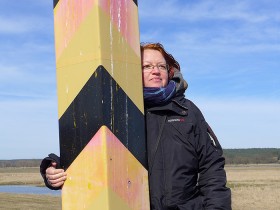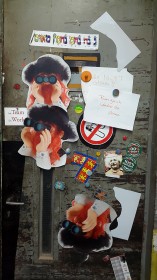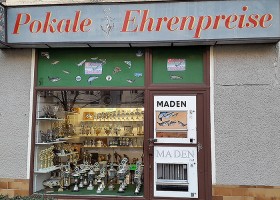Of all the things you can get from a vending machine…
Vending machines sell us a lot of the things we might need (or believe we need) through the day: drinks, sweets, cigarettes, inner tubes for bike tires, toothbrushes, and even anglers’ “supplies.” This last offer surprised me as a non-angler awhile back in the Berlin neighborhood of Wedding, starting with the lovely label “maggots.” I always make sure to take visiting guests by and show them too. As none of them are fishermen, they are always as startled as I was. → continue reading

Anna Adam, “Pastoral care for a German-Polish border post”, March 2015 © Jalda Rebling
It’s not easy to find the way there. Good thing that the artist picked me up at the nearest subway station in Berlin’s Wedding district. Together we cross the courtyards of various businesses, pass a halal diner, climb a staircase, and suddenly we’re standing in front of the door of her atelier. Hardly has Anna opened it when I see the “kosher gnome”, observing the world through his binoculars.
It’s this figure that the artist reproduced in paper cut-out form on a card for our art vending machine: you cut the card and fold it to create a three-dimensional object. The instructions state that you should set him in your kitchen and then everything will be ok.

Atelier Door with “Kosher Gnome” © Jewish Museum Berlin, Photography: Gelia Eisert
Anna, what does the odd name “kosher gnome” mean? How do “kosher” and “gnome” even fit together? How will everything be ok? I’m confused.
At home, a wichtel (in the original German) is an important little man. There are a lot of these “important men”. My “kosher gnome” was born in 2002. He’s definitely supposed to be confusing. “Kosher” and “gnome” fit together because I committed myself to the task of “healing the German-Jewish sickness”, as I call it. To that end I work with satirical means, which – unlike comedy – take everyday politics as a starting point.
You mentioned the year it was born. What were the circumstances of the “kosher gnome”‘s birth? → continue reading
The last few weeks have been full of hectic hustle and bustle, with boxes being passed from hand to hand, examined, unpacked, and sorted through. Such a variety of objects emerged from their cases and seemed to be disseminating in every direction through the museum.

© Jewish Museum Berlin, photo: Gelia Eisert
Blue prints were spread out over a long, dark red sheet. Words seemed to glow in them – was it “tekhelet” or “argaman” or both? And what do they mean anyway?

© Jewish Museum Berlin, photo: Gelia Eisert
A “magic” card appeared in a kitchenette. Suddenly everything was kosher: the sink, the refrigerator, the dishes, the whole kitchen. The artist promised it would be, and thus it happened. → continue reading




